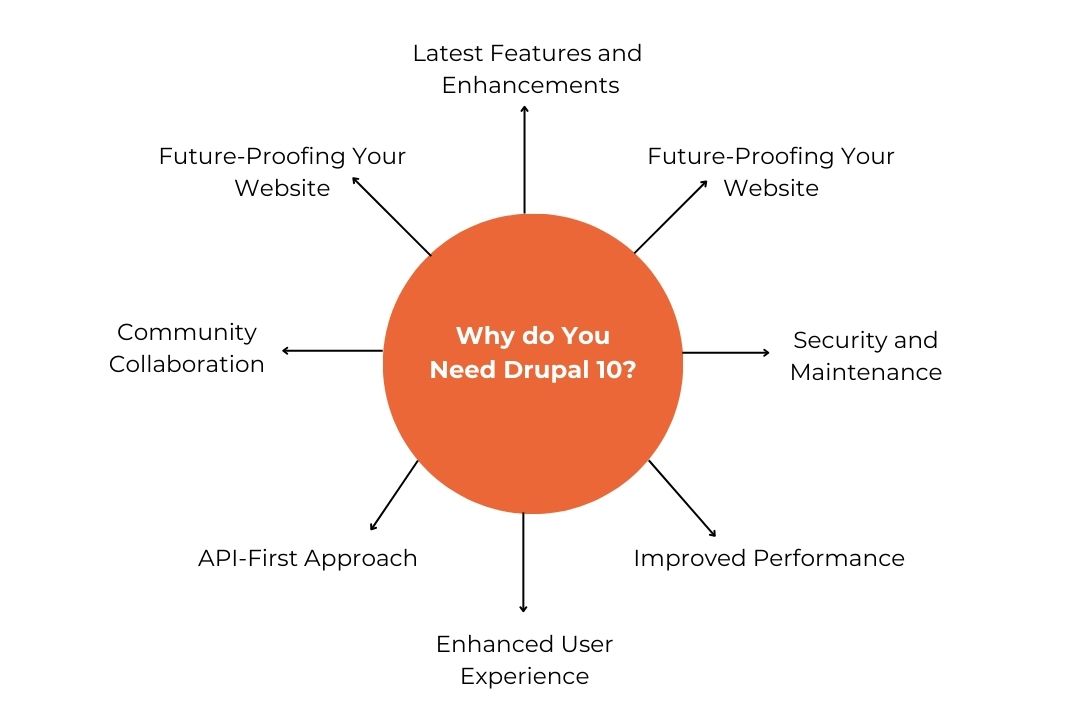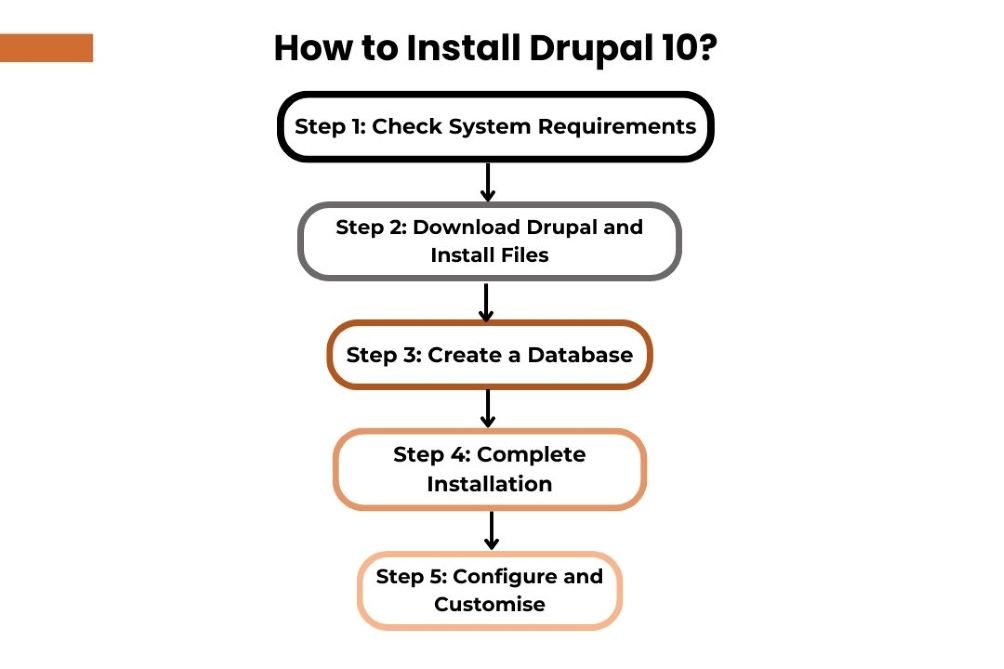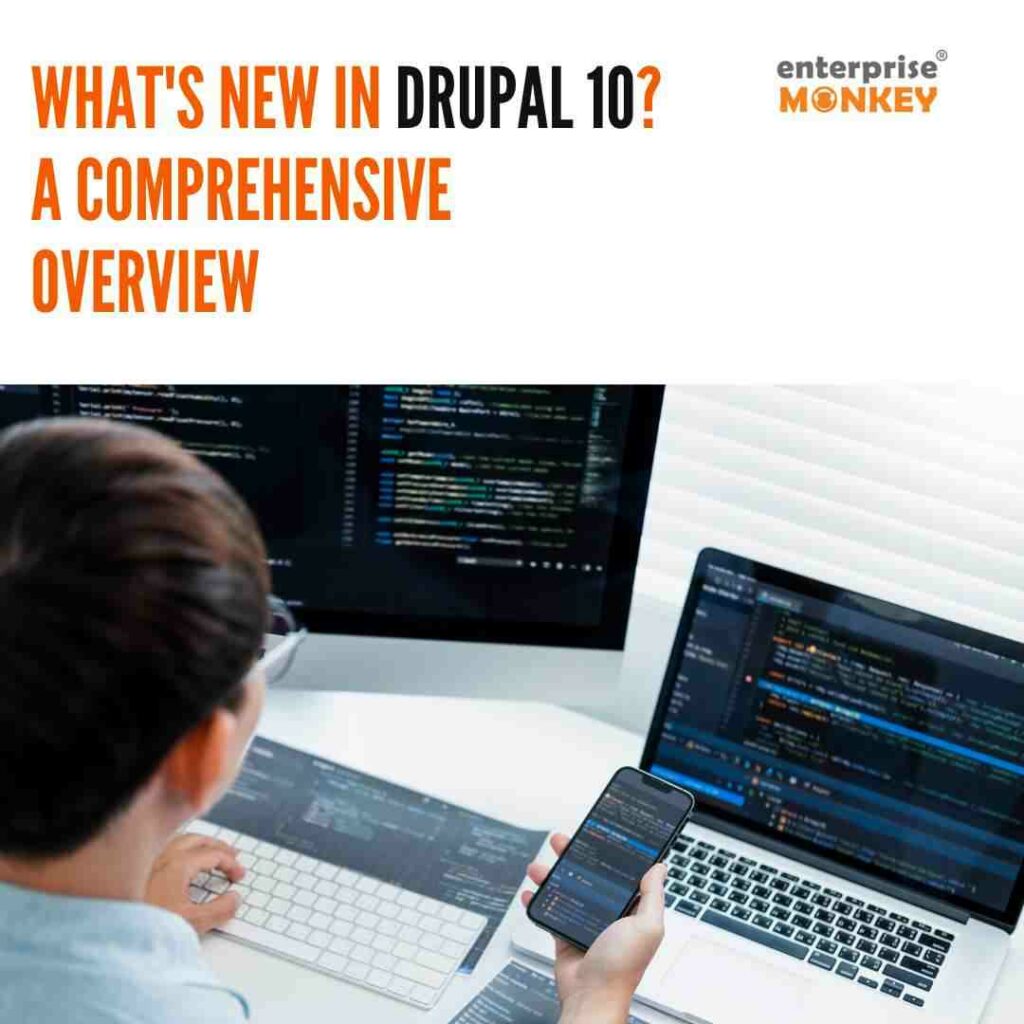Drupal is an open-sourced CMS, powering 2.3% of websites globally with a fair market share of 4.1% in the Content Market System market. With a considerable amount of websites running on this platform, Drupal continues to scale capabilities by bringing prominent improvements in its technological stack and features.
[Also read: Why Drupal is the Best CMS for Your Business?]
Continuing to stand as a beacon of innovation and progress, Drupal CMS has finally come up with its latest Drupal 10 version in the late 2022 to elevate the businesses running on this platform.

[Source: Drupal]
The release of Drupal 10 marks a significant milestone in the evolution of this powerful open-source content management system. Hence, to provide you with every insight about this robust update, we have come up with this information-loaded blog post.
Here, we will highlight how Drupal 10 empowers businesses, elevates user experiences, and sets the stage for the next era of web development.
Key Highlights of Drupal 10 release!
|
We will also learn about Drupal 10.1 and 10.2 updates and understand the installation process of this latest version and the upgrading/migration process from Drupal 8 or 9 to the newest version to set your website apart.
So, we welcome you to explore Drupal 10 with us in this blog post and unveil every detail you may require to use this innovative platform for your business website creation.
Let’s get started!
Drupal 10 Rollout: Latest Drupal Release

[Source: Drupal 10]
The source code of the Drupal content management system is free for anyone, making it one of the popular site builder choices amongst developers.
Drupal 9 and 9.3.x was released in June 2020 and introduced significant improvements over its predecessor, Drupal 8. The move to Drupal 9 was made smoother due to the adoption of Symfony 4 and 5 components, improved backward compatibility, and the removal of deprecated code.

Drupal versions evolve to incorporate the latest technologies, enhance security, improve performance, and provide new features. Following the same trend, Drupal CMS came up with its latest major version, Drupal 10.0 on 14 December 2022, within its regular release cycle of every three years. It has come up with better modular architecture, easier customisation and flexibility for users.
Drupal 10.0 is also available in its Beta release version for those theme authors or site owners who intend to take the compatibility test or upgrade paths for the latest version.
| Drupal 10’s official rollout date is 14 December 2022! |
What are the Features of Drupal 10?
Drupal 10 includes several new features, such as the Claro administration theme, Olivero default theme, and CKEditor 5, for better authoring experience and more modern editing. It has significant updates and enhancements, including improved accessibility features, enhanced multilingual capabilities, and a streamlined administrative interface.
| Famous Entities Use Drupal!
Many famous entities of the world rely on Drupal as their website-building and designing platform. Some examples of the top-rated companies using Drupal are:
Isn’t that amazing? |
Other features of Drupal 10 include improved performance and scalability and expanded support for decoupled and headless architectures. Additionally, upgraded security measures and better support for modern development practices such as continuous integration and deployment are included.
Let’s find out the Drupal 10 features in detail below:

1. Claro Administration Theme
Drupal is known for providing excellent editorial and customisation experience to users. To continue providing a high-end experience, Drupal 10 replaced the “Seven” administration theme with the Claro Admin with an improved user interface and functionalities.

[Source: Drupal]
Claro features a modern and clean design focusing on improving the overall user experience for administrators. It introduces updated visual elements, typography, and styling to create a more intuitive and aesthetically pleasing interface.
Additionally, the Claro backend theme is responsive, accessible, and consistent, ensuring a user-friendly experience across various screen sizes. So now, Claro is the default admin theme with Drupal 10 and will continue to receive regular updates with Drupal core releases.
2. Olivero Frontend Theme
Olivero has become a new frontend default theme of Drupal by replacing the earlier default Bartik theme. Olivero was selected through a community-driven initiative to design a fresh, modern theme that aligns with the evolving standards of web design and user experience.

[Source: Drupal Partners]
Olivero is designed to be modern and responsive, ensuring that websites built with Drupal and using the Olivero theme provide an optimal user experience across various devices and screen sizes. It provides a lightweight foundation while placing a strong emphasis on accessibility.
Having Olivero as the default theme contributes to a consistent user interface experience across Drupal installations. This helps users feel familiar and comfortable navigating Drupal sites, regardless of the specific content and customisation.
3. New Starterkit Theme
Drupal 10 has come up with the New Starterkit theme for the designers to create the themes as per their requirements. The developers can now use the customisable templates to build the websites using the newer and updated theme-building process compared to Drupal versions 8 and 9.
Drupal provides a set of predefined configurations, templates, and styles that serve as a foundation for building a Drupal website. Therefore, users can now develop a new and clean layout without extending the base theme.
4. CKEditor 5
Alongside Drupal 9, CKEditor 4 is reaching the end of its life. Therefore, Drupal 10 has moved on with launching the better and updated CKEditor 5 to offer a serene editing experience to users.

[Source:CKEditor]
CKEditor 5 is a powerful WYSIWYG (What You See Is What You Get) editor that allows users to format and edit text in a visually appealing way. It represents a complete rewrite of the editor with a modular architecture. It brings improvements in terms of customisation, extensibility, and performance.
The editor is designed to be more modern and flexible than CKEditor 4. It allows users to use frontend technologies like React and Angular for extensions and integrations by extensive API. Additionally, it removed the mark-up copy-paste issues while copying the content from Word Documents to Google Docs, giving more flexibility and ease to the content creators.
6. Module Browser and One-Click Installation
In Drupal, installing a module often involves downloading the module, extracting it, and placing it in the correct directory. A one-click installation feature in Drupal 10 streamlines this process, making it more accessible to users who may not be familiar with manual module installation steps.
Including a module browser and one-click installation feature in the latest version 10, Drupal aims to enhance the user experience for site administrators. By simplifying the process of discovering and installing modules, Drupal can lower the barrier for users who want to extend their site’s functionality.
7. Symphony 6 Update
Drupal is all set to embrace the new versions of Symfony that come with performance improvements, optimisations, and enhancements. This could contribute to overall performance gains in Drupal 10.
Symphony 6 will with the minimum mandate of PHP 8.1 support and guarantees the seamless backend processing enhancements for every Drupal 10 project. The upcoming integrations of Symphony 6 such as multilingual support, services, routing and locales are lined up with the Drupal 10 upgrade.
8. Decoupled Menus
Drupal 10 Decoupled Menu is primarily helpful for those who use Drupal as a headless CMS. The latest version allows a more straightforward update process, which means you can now use the administration panel to update your website menu.
The decoupled setup of Drupal 10 offers a more dynamic and interactive user experience by making the procedure easier. Hence, if your website runs on frontend technologies like React or Angular, you can make the updates quickly without extending the developer’s interventions.
9. Automatic Updates
The latest Drupal version, 10, has introduced an automatic update facility to the users to make the platform more user-friendly and intuitive. The feature is currently applicable to Drupal’s core updates and security updates. However, the Drupal community plans to extend this facility by including automatic minor and module updates for a better user experience.
How to Install Drupal 10?
Drupal 10 is in the market, and the earlier versions will likely face the end of life in the coming years.
| End of Life for Drupal 8 and Drupal 9
Drupal 10 marks the end of life for Drupal 8 (EOL – 2 November, 2021) and eventually Drupal 9 (EOL – 1 November, 2023). Upgrading to Drupal 10 becomes essential for organisations still on Drupal 8 or 9 to continue receiving support and security updates. |
Therefore, if you want to build your website on Drupal, understading the installation process of Drupal 10 is imperative. To install Drupal 10, follow the procedure outlined below:

Step 1: Check System Requirements
Before installing, ensure that your server environment meets the system requirements for running Drupal. This typically includes a web server (such as Apache or Nginx), a database server (such as MySQL or PostgreSQL), and PHP.
Step 2: Download Drupal and Install Files
Visit the official Drupal website to download the latest version of Drupal (Drupal 10). After downloading the Drupal package, extract the files to your web server’s document root or the directory where you want to install Drupal.
Step 3: Create a Database
Set up a database for Drupal to use. This involves creating a new database and a database user with the necessary permissions. Take note of the database name, username, and password, as you will need these during the installation process.
Step 4: Complete Installation
Once you’ve entered all necessary information, the installer will perform the installation process. After completion, you’ll receive a notification, and you can log in to the Drupal administration interface using the administrative account you created.
Step 5: Configure and Customise
After installation, you can configure and customise your Drupal 10 site according to your preferences. This includes theme selection, installing modules, and configuring site settings.
[Also read: Drupal Website Development Cost]
Migration Process from Drupal 8/9 to Version 10
Transitioning from Drupal 8 or 9 to Drupal 10 involves careful planning to ensure a smooth upgrade. Drupal provides guidelines and tools to facilitate the migration process. However, we will guide you with more precise information on the transitioning process.
Follow the checklist given below and start with the migration process of your Drupal 8 or 9 site to the latest Drupal 10 version:

- Check System Requirements
To streamline the process, verify that your server environment and system requirements align at the same point for Drupal 10, as outlined in the official documentation.Note: Before migrating to Drupal 10, make sure your Drupal 8 or Drupal 9 site is running the latest version of Drupal 9 (Drupal 9.5 version). Update core and contributed modules to their latest versions. [Want to read about other Drupal 9 versions? Click here]
- Verify Module and Theme Compatibility
Check the compatibility of contributed modules and themes with Drupal 10. Ensure all contributed modules and themes are updated to their latest Drupal 9 versions before starting migration. - Backup Your Site
Before initiating the Drupal 10 migration on your live site, perform comprehensive backups of your Drupal 8 or Drupal 9 site, including the database and files. - Perform Migration
Follow the recommended migration paths provided by Drupal for migrating from Drupal 8 or Drupal 9 to Drupal 10. Drupal 10 includes migration tools and scripts to assist with the process. - Conduct Thorough Testing
Perform thorough functional testing on the migrated site to ensure all features and functionalities work as expected. Alongside, evaluate the performance of the migrated site to identify and address any performance-related issues. - Deploy to Production
Once testing is successful, deploy the Drupal 10 migration to your production site. Monitor your production site closely after the migration and check logs for any errors or issues.
Some Insights on Drupal 10.1 and 10.2 Updates
Drupal 10.0 release has also introduced minor updates with 10.1 and 10.2 releases.
Once successfully migrating to Drupal 10, you can take a leap and upgrade your site with the latest 10.1 or 10.2. These are incremental updates to address bug fixes, security vulnerabilities, and other issues identified after the initial major release. These updates aim to improve the stability and security of the Drupal platform.
Conclusion
Exploring the latest Drupal 10 version promises an exciting journey into a cutting-edge content management system that embodies innovation, security, and enhanced user experiences. With its robust features, improved performance, and commitment to accessibility, Drupal 10 is set to empower developers and content creators alike.
Therefore, futureproof your website and contact a seasoned drupal website development agency to stay ahead of competitors. Whether you need migration support or want to develop an entirely new Drupal site, don’t hesitate to join hands with an expert Drupal development team and observe the maximum benefits of the latest Drupal 10 version.
FAQs
Q1: Is it necessary to upgrade to Drupal 10 immediately?
Ans: While upgrading to the latest version is advisable for security and performance reasons, the urgency depends on your site’s specific needs. Drupal generally supports multiple versions simultaneously, allowing for a phased upgrade approach.
Q2: What are the system requirements for Drupal 10?
Ans: Drupal 10 will have specific system requirements that you should review before upgrading. This typically includes supported versions of PHP, databases, and web servers. Check the official documentation for the most accurate information.
Q3: Can I test Drupal 10 before upgrading my live site?
Ans: Yes, it’s advisable to set up a staging environment to test the Drupal 10 upgrade before applying it to your live site. This allows you to identify and address any issues in a controlled environment.
Q4: Should I hire a Drupal Development Agency for my project?
Ans: It is advisable to hire a professional Drupal Development Agency for your project because agencies bring a wealth of expertise to design, develop, and maintain your website, ensuring it aligns with industry best practices, security standards, and the latest Drupal capabilities.
Q5: How do I choose the right Drupal development agency for my project?
Ans: Consider factors such as the agency’s experience with Drupal, portfolio of past projects, client testimonials, expertise in specific industries, and their approach to project management. Ensure they align with your project requirements and have a proven track record of successful Drupal implementations.













